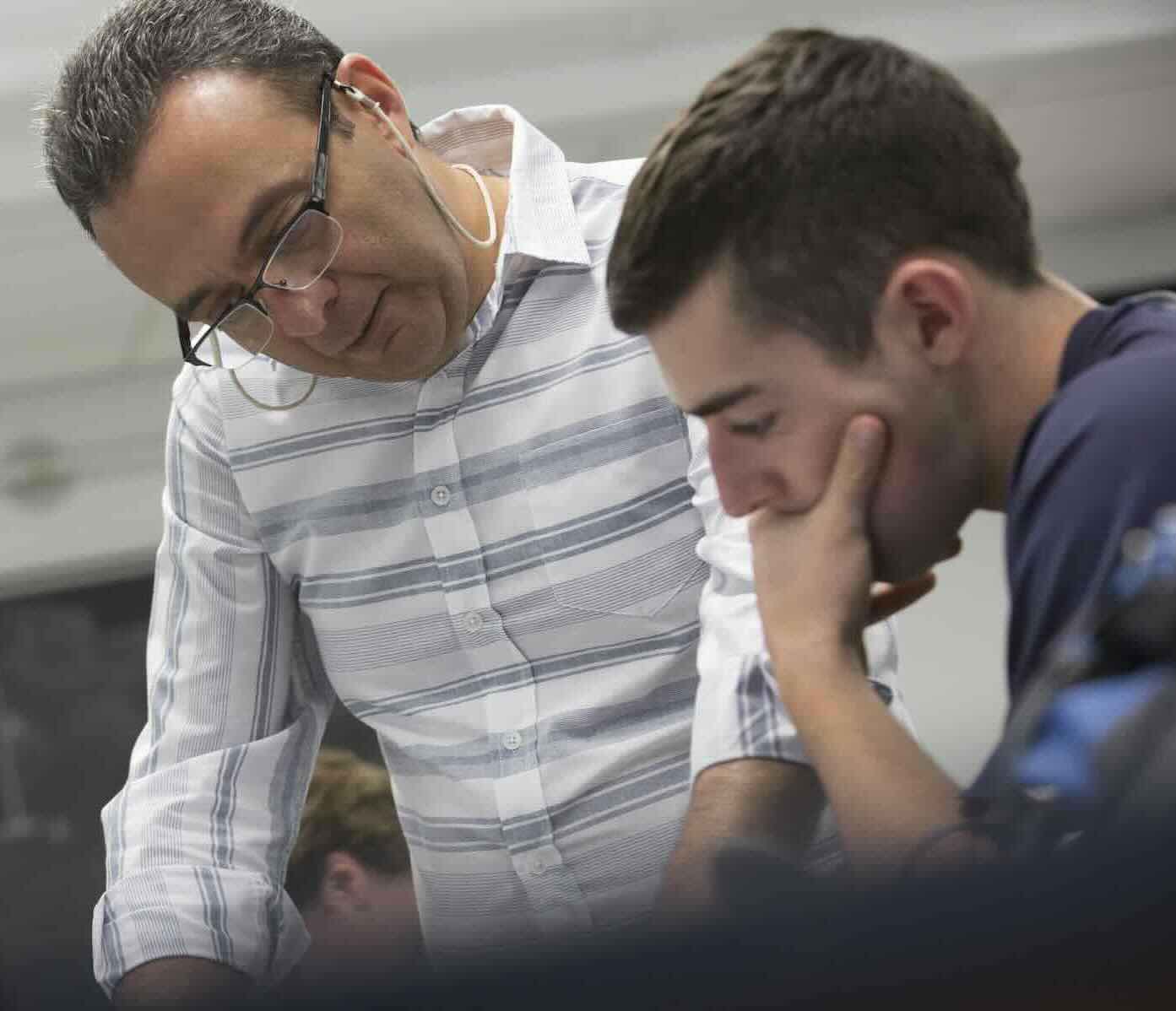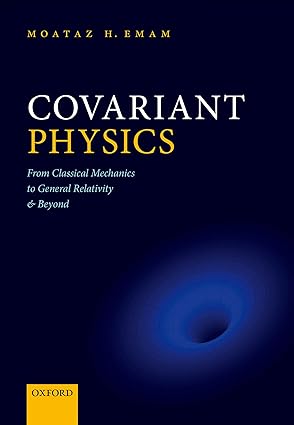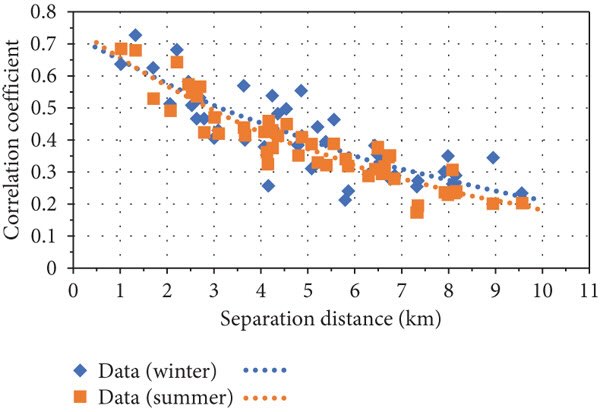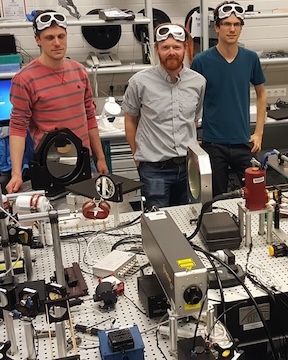The faculty in the Physics Department are involved in a wide range of research projects spanning experimental projects with solar panels, to the design of laser imaging systems, to theoretical projects describing the spacetime of inside-out black holes in 5 dimensions!
Students who are interested in research (which can count for credit toward graduation through Independent Studies) are encouraged to inquire about opportunities. Typically, starting research in the second or third year is ideal so that you have a strong background in the fundamentals of physics and calculus and sufficient time to make a substantial contribution.
SUNY Cortland hosts two important events that highlight student research. The Undergraduate/Alumni Science Symposium is held in the fall and brings together students, faculty, and successful alumni from a broad range of STEM disciplines. Students have the opportunity to present their research in a poster session, with a few outstanding students selected for keynote talks. In the spring, SUNY Cortland hosts its Transformations event, which features research from all disciplines across the campus. Both of these events are totally voluntary and are great opportunities for students to acquire public speaking and presentation experience prior to grad school or entering the workforce.

Professor Moataz Emam is a theoretical physicist whose work examines the smallest and the largest scales of the universe. At the smallest scales, Professor Emam is helping to advance string theory, which is a description of fundamental particles in 10 or 11 dimensions. At the largest scales, Professor Emam is working on generalizations of Einstein's theory of general relativity that can describe the structure of the entire universe. He was awarded the SUNY Chancellor’s Award for Excellence in Scholarship and Creative Activities in 2024.

Professor Emam is the author of Covariant Physics, an undergraduate textbook on the subject of general relativity, published by Oxford University Press. Professor Emam uses this text in his General Relativity course (PHY 445) at SUNY Cortland.
 Professor Douglas Armstead's work focuses on applications of solar panel technology as a renewable energy source for large scale deployment on the grid. He is also a partner in a local company that designs and installs residential solar power systems.
Professor Douglas Armstead's work focuses on applications of solar panel technology as a renewable energy source for large scale deployment on the grid. He is also a partner in a local company that designs and installs residential solar power systems.
 Professor Armstead co-authored a paper titled "Local and regional PV power variability in the northeastern US: Implicationsfor simplified utility flicker screening analyses" in the Journal of Energy. This work examined the robustness of the electric grid with wide-scale adoption of photo-voltaic (solar panel) power systems. These systems are prone to variability due to changes in local weather, which must be compensated at the grid-level. Armstead argues that a threshold condition for PV power integration can largely solve the so-called "flicker" problem.
Professor Armstead co-authored a paper titled "Local and regional PV power variability in the northeastern US: Implicationsfor simplified utility flicker screening analyses" in the Journal of Energy. This work examined the robustness of the electric grid with wide-scale adoption of photo-voltaic (solar panel) power systems. These systems are prone to variability due to changes in local weather, which must be compensated at the grid-level. Armstead argues that a threshold condition for PV power integration can largely solve the so-called "flicker" problem.
 Professor Eric Edlund's research is eclectic. His most recent studies have focused on orbital dynamics. He has an ongoing collaboration with MIT and the Wendelstein 7-X project at the Max Planck Institute for Plasma Physics in Greifswald, Germany, where he designed and built an optical device called a phase contrast imaging system for studying turbulence in fusion plasmas. He has also published papers with colleagues from the Economics Department and the Art Department at SUNY Cortland. A full list of his publications can be found on his personal website.
Professor Eric Edlund's research is eclectic. His most recent studies have focused on orbital dynamics. He has an ongoing collaboration with MIT and the Wendelstein 7-X project at the Max Planck Institute for Plasma Physics in Greifswald, Germany, where he designed and built an optical device called a phase contrast imaging system for studying turbulence in fusion plasmas. He has also published papers with colleagues from the Economics Department and the Art Department at SUNY Cortland. A full list of his publications can be found on his personal website.
Professor Edlund recently published a paper titled "Lagrange Points and Regionally Conserved Quantities" in the American Journal of Physics (AJP), which is freely available to the public (the pdf is much easier to read than the online version). This paper presents new insights into a classic problem in orbital dynamics that is over 250 years old. Figure 6 of this article was selected for the cover of the June 2024 issue of AJP. He and current student, Ryan Hayes, are working on a follow-up article to this paper that they plan to submit for review later this year.
 Lecturer Sean Nolan’s research focuses on science education at the secondary and higher education levels. Mr. Nolan is currently engaged in a 5 year long case study exploring culturally responsive science teaching of former SUNY Cortland science education majors. Additionally, Mr. Nolan has given presentations regarding Wooclap, an online polling software that he utilizes to engage and assess students in large lecture classes. Mr. Nolan presented some of his work in a Woobinar (a seminar using WooClap).
Lecturer Sean Nolan’s research focuses on science education at the secondary and higher education levels. Mr. Nolan is currently engaged in a 5 year long case study exploring culturally responsive science teaching of former SUNY Cortland science education majors. Additionally, Mr. Nolan has given presentations regarding Wooclap, an online polling software that he utilizes to engage and assess students in large lecture classes. Mr. Nolan presented some of his work in a Woobinar (a seminar using WooClap).



 Professor Armstead co-authored a paper titled "
Professor Armstead co-authored a paper titled " Professor Eric Edlund's research is eclectic. His most recent studies have focused on orbital dynamics. He has an ongoing collaboration with MIT and the
Professor Eric Edlund's research is eclectic. His most recent studies have focused on orbital dynamics. He has an ongoing collaboration with MIT and the  Lecturer Sean Nolan’s research focuses on science education at the secondary and higher education levels. Mr. Nolan is currently engaged in a 5 year long case study exploring culturally responsive science teaching of former SUNY Cortland science education majors. Additionally, Mr. Nolan has given presentations regarding Wooclap, an online polling software that he utilizes to engage and assess students in large lecture classes. Mr. Nolan presented some of his work in a
Lecturer Sean Nolan’s research focuses on science education at the secondary and higher education levels. Mr. Nolan is currently engaged in a 5 year long case study exploring culturally responsive science teaching of former SUNY Cortland science education majors. Additionally, Mr. Nolan has given presentations regarding Wooclap, an online polling software that he utilizes to engage and assess students in large lecture classes. Mr. Nolan presented some of his work in a